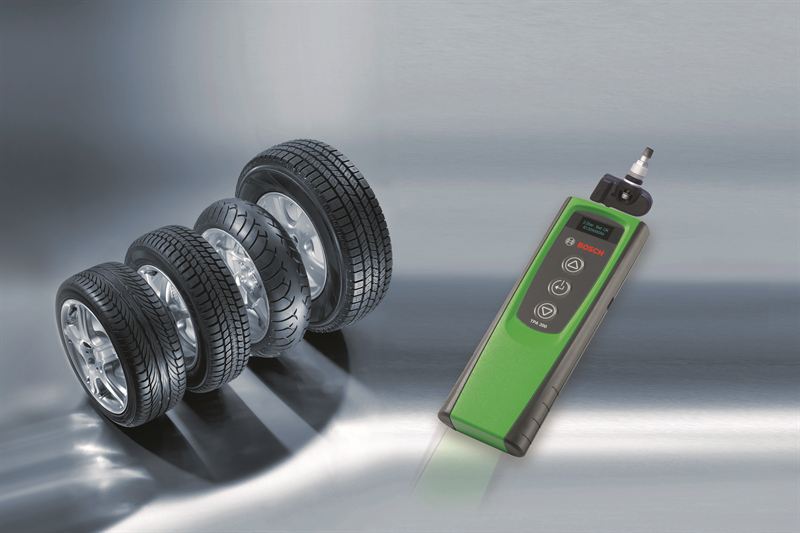Bosch launches intuitive yet advanced TPMS tool
- Highly advanced tyre pressure monitoring diagnostic tool
- Helps workshops support latest MOT requirements
- Works independently, and in combination with ESI[tronic] and KTS systems

With EU legislation making TPMS mandatory on vehicles, the Bosch TPA 200 is a powerful tool for ensuring workshops achieve fast and accurate TPMS diagnosis.
The tool is used in conjunction with Windows-based software called TPA Startcenter, downloadable via the Smartcenter website, which provides technicians with a wide range of support data.
With recent changes to MOT requirements, making a TPMS fault light an MOT failure, the opportunities for companies to capitalise on identifying TPMS issues with the TPA 200 are impossible to ignore.
The Bosch TPA 200 has coverage on both direct and indirect TPMS systems, and is also able to diagnose and service TPMS sensors and valves, giving workshops the chance to capitalise on MOT opportunities.
Originally appearing on vehicles from 2001 onwards, TPMS has gradually gained popularity over the years. While it has been mandatory on all new vehicles since November 2014, it was required on all new model year vehicles since November 2012. The first wave of MOT tests for these cars are now imminent.
Profit opportunity
Allowing workshops to exploit lucrative tyre work on vehicles while improving customer retention, the remote control-sized kit promises to have broad market appeal, ranging from small to large workshops to fast fit firms. The TPA 200 is also quick to set-up and intuitive to use for technicians,
Able to read and display data independently, the Bosch TPA 200 also complements both KTS modules and ESI[tronic] to provide a complete diagnostic TPMS solution. Compatible with both direct and indirect TPMS, advanced functions on the TPA 200 include a copy mode, useful when swapping sensors on replacement wheels and fitting universal TPMS sensors.
Software solutions
Offering charging and software updates via a USB port, Bluetooth connectivity also allows the TPA 200 to communicate with a PC, giving workshops the opportunity to record TPMS servicing work. Handily, the device does not timeout, ensuring a long service life for workshop productivity.
The TPA 200 also comes with Windows-based software called TPA Startcenter, which provides technicians with a wide range of support data. This includes the type of TPMS system on board any given TPMS-equipped vehicle, torque settings relating to the valve stem/nut, OEM and universal sensor part numbers, and TPMS relearn instructions. The Startcenter software is downloadable via the Smartcenter website.
The TPA 200 is available from leading Bosch distributors.

ENDS
Press Contacts:
Rachel Burgess – rburgess@automotivepr.com or 020 7952 1076
Matt Sanger – msanger@automotivepr.com or 020 7952 1079
The Bosch Group is a leading global supplier of technology and services. In 2013, its roughly 281,000 associates generated sales of 46.1 billion euros. (NB: Due to a change in accounting policies, the 2013 figures can only be compared to a limited extent with the 2012 figures). Its operations are divided into four business sectors: Automotive Technology, Industrial Technology, Consumer Goods, and Energy and Building Technology. The Bosch Group comprises Robert Bosch GmbH and its more than 360 subsidiaries and regional companies in some 50 countries. If its sales and service partners are included, then Bosch is represented in roughly 150 countries. This worldwide development, manufacturing, and sales network is the foundation for further growth.
In 2013, the Bosch Group invested some 4.5 billion euros in research and development and applied for some 5,000 patents. This is an average of 20 patents per day. The Bosch Group’s products and services are designed to fascinate, and to improve the quality of life by providing solutions which are both innovative and beneficial. In this way, the company offers technology worldwide that is “Invented for life.”
The company was set up in Stuttgart in 1886 by Robert Bosch (1861-1942) as “Workshop for Precision Mechanics and Electrical Engineering.” The special ownership structure of Robert Bosch GmbH guarantees the entrepreneurial freedom of the Bosch Group, making it possible for the company to plan over the long term and to undertake significant up-front investments in the safeguarding of its future. 92 percent of the share capital of Robert Bosch GmbH is held by Robert Bosch Stiftung GmbH, a charitable foundation. The majority of voting rights are held by Robert Bosch Industrietreuhand KG, an industrial trust. The entrepreneurial ownership functions are carried out by the trust. The remaining shares are held by the Bosch family and by Robert Bosch GmbH.



